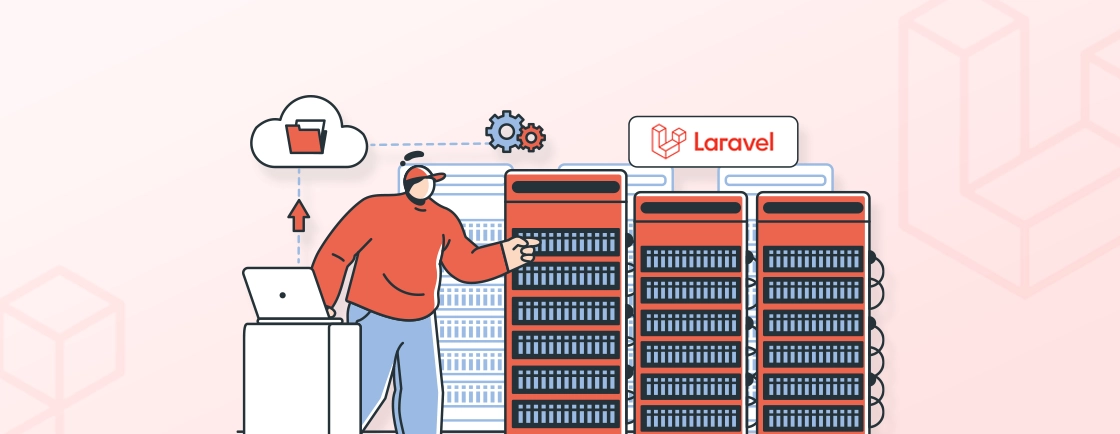Quick Summary
Database seeding in Laravel automates populating your database with initial or test data. Using seeders and factories, developers can generate consistent, realistic datasets. This is crucial for efficient application testing, creating uniform development environments, and ensuring all team members work with the same foundational data.
Table of Contents
A well-structured database is the backbone of any dynamic application. While Laravel migrations define your database schema, database seeding populates that structure with initial data. So developers can automatically generate a consistent set of data directly into the database. Like, default users, product catalogs, or categories.
Database seeding in Laravel provides a reliable and repeatable dataset. It’s indispensable for streamlining application testing, creating a uniform development environment, and starting demo versions.
So, this blog sheds light on Laravel seeder, how it helps, and how you can set it up for faster development and testing. Let’s start.
What is Database Seeding in Laravel?
Database seeding is the process of populating your database with dummy or initial data. In Laravel, this is done using special classes called “Seeders”. With these classes, you can automatically insert data into your tables, saving you from manual input.
Purpose in Application Development & Testing
Seeding is crucial for two main reasons:
- Development: It provides a consistent dataset for all developers to work with. That ensures the application behaves the same way on every machine.
- Testing: It allows you to test features with a predictable and repeatable set of data. That makes your tests more reliable.
How Laravel Simplifies the Seeding Process
Laravel makes seeding straightforward. You can use:
- Model Factories: To generate large amounts of fake, realistic data.
- The DB Facade: To directly insert specific, predefined records.
A single Artisan command (php artisan db:seed) then executes the seeder to fill your database.
Difference Between Seeding and Migration
Think of migration and seeding as a two-step process for your database:
- Migrations create and modify the structure of your database tables (e.g., adding columns).
- Seeders fill the constructed tables with the actual data.
You can leverage the seeding functionality for efficient development, testing and user management in Laravel.
Why Use Database Seeding in Laravel?
Seeding is a key functionality in development and testing. It ensures a range of key advantages.
Better Development Efficiency
With seeding in place, you won’t have to manually create test data for every development iteration. It saves the developers time and effort, so they can focus on building functionalities and logic rather than data entry.
Ensured Testing Consistency
You can use the same seeded data set for tests to achieve consistent and repeatable results. That makes it easier to identify and fix bugs effectively since the changes in behavior will be the same.
Realistic Testing Scenarios
Try to seed data that reflects real-world use cases to test the application’s behavior under more realistic conditions. You can identify potential issues with basic test data, leading to a bug free product.
Faster Development Iteration
Seeding ensures pre-populated data is readily available. So developers can quickly iterate on functionalities without recreating data each time. That means faster development cycles and quicker bug fixes.
Helps Automate Dummy Data Generation
With Laravel’s model factories, you can generate vast amounts of realistic, fake data programmatically. This automates the setup process for any application state required for development or QA.
Supports Multi-Environment Setup (Local vs Production)
Seeders allow for environment-specific data. You can seed fake data for local development and staging. Meanwhile, use a seeder to insert essential initial records (like admin users or product categories) in production.
Other than these, seeding databases in Laravel is a great way to create realistic demo environments for clients.
Prerequisites & Setup for Laravel Seeding Database
Before you can seed your database, ensure the following foundational elements are in place. (We assume you have an active Laravel project with latest version installed)
Configured Database Connection
Your .env file must have correct database credentials (DB_DATABASE, DB_USERNAME, DB_PASSWORD) so Laravel can connect to your database.
Executed Database Migrations
Your database tables must exist. Run php artisan migrate to execute your migrations and build the necessary table structure before seeding data into them.
Model Factories (Optional but Recommended)
For generating large volumes of fake data, create a model factory using php artisan make:factory PostFactory. This simplifies the creation of realistic, randomized records.
How to Seed a Database in Laravel?
Seeding populates your database with initial data, streamlining development and testing. Here’s how you seed a database.
Step 1: Create a Laravel Seeder Class
Use Artisan to generate a new seeder. This creates a file in the database/seeders directory.
php artisan make:seeder UsersTableSeeder
Step 2: Define Seeder Logic
Within the run method of your new seeder, define the data to be inserted. You can use Eloquent models or the DB facade.
// In database/seeders/UserSeeder.php
use Illuminate\Database\Seeder;
use Illuminate\Support\Facades\DB;
use Illuminate\Support\Str;
class UsersTableSeeder extends Seeder
{
public function run()
{
DB::table('users')->insert([
'name' => Str::random(10),
'email' => Str::random(10) . '@example.com',
'password' => bcrypt('password'),
]);
}
}
This step defines the data insertion logic in the seeder file. It specifies what data should be added to the database. Implement database transactions in Laravel for consistency when seeding complex or interdependent data.
If any part of your seeding operation fails, transactions automatically roll back all changes. It prevents partial data insertion that could corrupt your database.
Step 3: Register the Seeder in DatabaseSeeder.php
To organize multiple seeders, call them from the main DatabaseSeeder class.
// In database/seeders/DatabaseSeeder.php
use Illuminate\Database\Seeder;
class DatabaseSeeder extends Seeder
{
public function run()
{
$this->call([
UserSeeder::class,
// PostSeeder::class,
]);
}
}
Step 4: Run the Seeder Command
Execute the seeder using the Artisan command. This will run the run method in your DatabaseSeeder.
php artisan db:seed
To run a specific seeder directly, use the –class option:
php artisan db:seed --class=UserTableSeeder
It will run the UserTableSeeder class. Laravel file storage provides a unified API to store, retrieve, and organize files associated with seeded data.
Step 5: Use Model Factories
Laravel provides a convenient way to create dummy data using factories. For generating many fake records, first create a model factory.
php artisan make:factory UserFactory --model=User
Step 6: Define Model Factory
In the generated factory, define the structure and fake data for your model using Faker.
use App\Models\User;
use Illuminate\Database\Eloquent\Factories\Factory;
use Illuminate\Support\Str;
class UserFactory extends Factory
{
protected $model = User::class;
public function definition()
{
return [
'name' => fake()->name(),
'email' => fake()->unique()->safeEmail(),
];
}
}
Step 7: Update Seeder Class to Use Factory
Modify your seeder to use the factory, for example, to create 50 fake users.
// In database/seeders/UserSeeder.php
use Illuminate\Database\Seeder;
use App\Models\User;
class UsersTableSeeder extends Seeder
{
public function run()
{
\App\Models\User::factory()->count(50)->create();
}
}
This code will update the seeder class that will ensure error free seeding when we run it.
Step 8: Run All Seeders
Finally, run the db:seed command. Laravel will execute the DatabaseSeeder. It calls your UserSeeder, populating the database with 50 fake user records.
php artisan db:seed
php artisan db:seed --class=User
This command runs all seeders registered in DatabaseSeeder, populating the database with all the initial data defined.
Using factories simplifies the generation of large amounts of dummy data. That makes the seeding process more efficient and realistic. Consult with an experienced Laravel development agency for managing the complete process and ensuring the best results.
Advanced Techniques for Seeding in Laravel
Now let’s move beyond the basic database seeding in Laravel. These techniques enhance control, efficiency, and realism in your database population.
Seeding from JSON or CSV Files
You can read from external files for importing large, pre-defined datasets. Like, a list of countries, product catalogs, or historical data.
public function run()
{
$countries = json_decode(file_get_contents(database_path('data/countries.json')), true);
foreach ($countries as $country) {
DB::table('countries')->insert($country);
}
}
Seeding Data from SQL Dumps or APIs
You can leverage existing data sources directly.
- SQL Dumps: Execute raw SQL files for complex, relational data imports using DB::unprepared(file_get_contents(‘path/to/dump.sql’)).
- APIs: Fetch live data from an internal or external API within your seeder to populate your database with current information.
Environment-Based Seeding (Local vs Production)
Control what data is seeded in different environments. Use the App::environment() function to conditionally run seeders.
public function run()
{
// Seed fake users only in local development
if (app()->environment('local')) {
\App\Models\User::factory(10)->create();
}
// Always create the essential admin user
\App\Models\User::factory()->admin()->create();
}
Generate Seeders from Existing Data Using iSeed
The iseed package is a powerful tool for reverse-engineering. It can generate a seeder class from your existing database tables. That is invaluable for replicating a production-like dataset in staging or for creating snapshots of development data.
Final Summary
In the area of testing, database seeding has emerged as a powerful tool in Laravel development. By strategically injecting pre-defined data sets into your database, you can unlock advantages such as:
- Streamlined development
- Consistent testing
- Realistic testing Scenarios
- Faster development iterations
So, businesses seeking their development to be bug free and efficient should hire Laravel developers with us. They can implement seeding practices along with complete development of Laravel applications.
FAQs Seeding Database in Laravel
Can I control the order in which data is seeded?
Yes. The DatabaseSeeder class acts as a central coordinator. You can use the call method within seeder classes to run them in a particular order. This control is especially used if tables have data dependencies.
Why is seeding databases important in Laravel?
Seeding databases in Laravel is important because it allows you to easily set up a database with initial data that your application can use. This saves time and effort when setting up a new project and ensures that your application has the necessary data to function properly.
Can I version-control my seeders?
Yes, seeders can be version-controlled along with your application code. This ensures that all team members have access to the same initial dataset. It facilitates collaboration and consistency across different development environments.
Can I seed sample documents or photos during Laravel file upload?
Database seeding and Laravel file upload can populate folders with sample files like user profile photos and demo documents. Using Laravel’s built-in ways to store uploaded files and reference their paths in seeders creates a realistic development environment that tests data and file handling.
Do Laravel database queries need optimization when using lots of seeded data?
Yes, Laravel database queries must be optimized to retain quick performance as your development environment develops with seeded data. Efficient searches speed your app load times and simulate production. Use eager loading, indexing, and query caching with seeded sample data to keep your database responsive and scalable.
What’s the difference between factory() and faker()?
factory() is a Laravel method for generating and persisting complete Eloquent models. Faker (or fake()) is a PHP library for generating random, dummy data (like names, emails, text) inside your factories to populate model attributes. The factory uses Faker to build the model’s data.
How can I run seeders in production safely?
Use seeders in production only to insert essential, non-test data. Always conditionally check the environment and seed absolute necessities, such as initial admin roles or core product categories. Never use Model::factory()->count(100)->create() in a production environment.
Speed Up Testing with Laravel Database Seeding
Populate your Laravel database effortlessly for development and testing. Our team can help you set up efficient seeders to save time and boost productivity.




